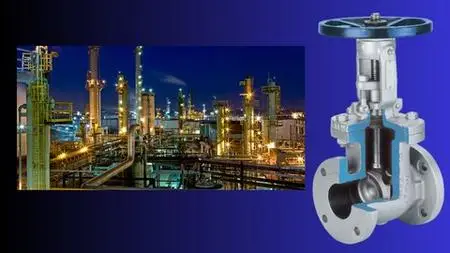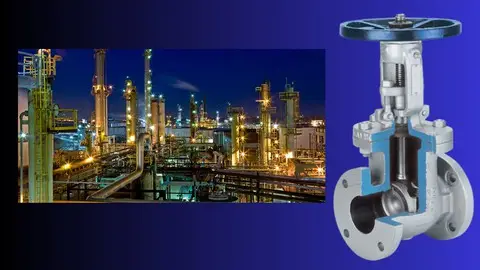Mastering Piping Valve Material Specifications (Vms)
Published 6/2023
MP4 | Video: h264, 1280x720 | Audio: AAC, 44.1 KHz
Language: English | Size: 6.09 GB | Duration: 10h 31m
Published 6/2023
MP4 | Video: h264, 1280x720 | Audio: AAC, 44.1 KHz
Language: English | Size: 6.09 GB | Duration: 10h 31m
Valve Material Specification (VMS) for Piping Engineers
What you'll learn
Valve Material Specification (VMS): How to Prepare VMS
Valve Numbering System
Valve Index
Valve Datasheet
API 600
API 6D
API 598
Components of API 600 Gate Valves
Components of API 602 Gate Valves
Components of API 6D Gate Valves
Components of API 6A Gate Valves
Material of Construction for Valves (CS, LTCS, AS & High Temperature Carbon steel)
Requirements
Awareness of Piping Engineering, You will learn everything about Valve Material Specification (VMS)
Description
Discover the comprehensive Valve Material Specification (VMS) course tailored specifically for piping engineers involved in the selection, design, and specification of valves for industrial applications. Gain an in-depth understanding of the requirements and standards that govern valve selection and procurement, equipping you with the knowledge and skills necessary for optimal valve material specifications.Sections of the Course on VMS:Scope: Explore the essential scope and objectives of the Valve Material Specification (VMS) course, emphasizing the significance of proper valve selection and material specifications in ensuring safe and efficient piping system operations.Abbreviation: Familiarize yourself with industry-specific abbreviations and acronyms relevant to valve material specifications, enhancing your understanding of the terminology used in valve engineering.Reference Documents: Introduce yourself to the vital reference documents that serve as the foundation for valve material specifications. Gain insight into industry codes, standards, and guidelines essential for selecting suitable valves for specific applications.Valve Numbering System: Understand the importance of the valve numbering system for identification and traceability purposes. Acquire knowledge of the valve numbering system's role in facilitating efficient valve management throughout the lifecycle of a piping system.General Notes: Grasp the significance of including specific instructions, requirements, and limitations in the general notes of valve material specifications. Ensure accurate valve selection and procurement by incorporating crucial details in your specifications.Attachments: Gain an understanding of the crucial role attachments play in valve material specifications. Learn how to effectively interpret and utilize various attachments such as drawings, diagrams, and technical datasheets to enhance your specification process.Valve Index: Appreciate the significance of valve indexing for accurate record-keeping, streamlined maintenance activities, and smooth piping system operations. Develop an understanding of how valve indexing functions within valve material specifications.Valve Datasheets: Master the art of reading, interpreting, and creating valve datasheets. Discover the critical parameters to consider when selecting valves based on their specifications, materials, and performance characteristics.Inspection Requirements: Comprehend the importance of inspection requirements in ensuring compliance with specifications, standards, and quality assurance. Familiarize yourself with the various testing and inspection methods employed during valve procurement and fabrication processes.Material Section of Valves: Dive into the material section of valves, delving into the selection criteria for different materials. Explore the chemical and mechanical properties of materials like carbon steel, low-temperature carbon steel, stainless steel, and high-temperature carbon steel. Understand the relevant ASTM standards associated with each material type.Anatomy of Gate Valves: Explore the anatomy of gate valves according to API standards. Gain knowledge about the 17 components specified by API 600, the 58 components specified by API 602, and the 14 components specified by API 6D and API 6A. Enhance your understanding of gate valves and their components.API Standards: Discover the API standards applicable to valve material specifications, including API 600 and API 6D. Understand the requirements and guidelines outlined in these standards to ensure proper valve selection and material specifications.Valve Trims and Non-Trims: Learn the material selection criteria for valve trims and non-trims. Explore the significance of selecting appropriate materials for valve internals to achieve optimal performance and durability.Trims and Non-Trims Identifications: Master the methods and markings used to identify valve trims and non-trims. Understand how to interpret and recognize different trim materials based on industry standards and specifications.Information Sources and Sequences: Gain insights into various sources of information available for valve material specifications. Understand the sequence of steps involved in extracting relevant clauses and tables from API standards and other reference documents.Embark on the Valve Material Specification (VMS) course and emerge equipped with the knowledge and skills to create, interpret, and implement valve material specifications effectively as a proficient piping engineer.
Overview
Section 1: Course Index : Valve Material Specifications
Lecture 1 Content Covered
Section 2: Introduction to VMS
Lecture 2 What is VMS & It's Importance
Section 3: Various Sections of VMS
Lecture 3 Scope
Lecture 4 Abbreviations in VMS document
Lecture 5 References of VMS
Lecture 6 Numbering System for Valves
Lecture 7 General Notes in VMS Document
Lecture 8 Attachments of VMS Document
Section 4: Attachment-1: Valve Index
Lecture 9 All About Valve Index
Section 5: Attachment-2: Valve Datasheet
Lecture 10 Introduction to Valve Datasheet & Various Sections
Section 6: Attachment-2: Section-1: General Section of Valve Datasheet
Lecture 11 Section-1: General Section of Valve Datasheet
Section 7: Attachment-2:: Section-2: Design Section of Valve Datasheet
Lecture 12 Section-2: Design Section of Valve Datasheet
Lecture 13 Classification of Valves
Lecture 14 Isolation Valves
Lecture 15 Regulation Valves
Lecture 16 Non-Return Valves
Section 8: Attachment-3:: Section-3: Material Section of Valve Datasheet
Lecture 17 Introduction to Material Section of Valve Datasheet
Section 9: Important Valve API Standards
Lecture 18 All About API 600
Lecture 19 All About API 6D
Section 10: Understanding Material of Valves (MOC)
Lecture 20 Index of Valve MOC
Lecture 21 Carbon Steel Valves (ASTM Standards)
Lecture 22 Low Temperature Carbon Steel Valves (ASTM Standards)
Lecture 23 Stainless Steel Carbon Steel Valves (ASTM Standards)
Lecture 24 High Temperature Carbon Steel Valves (ASTM Standards)
Section 11: 17 Components of API 600 Gate Valves
Lecture 25 Content Covered
Lecture 26 Scope of API 600 Standard
Lecture 27 Salient Features of API 600 Standard
Lecture 28 Brief about API 600
Lecture 29 API 600 Valve Body Parts_Body
Lecture 30 API 600 Valve Body Parts_Gate
Lecture 31 API 600 Valve Body Parts_Bonnet
Lecture 32 API 600 Valve Body Parts_Stem
Lecture 33 API 600 Valve Body Parts_Packing Gland
Lecture 34 API 600 Valve Body Parts_Gland Flange
Lecture 35 API 600 Valve Body Parts_Handwheel
Lecture 36 API 600 Valve Body Parts_Seat ring
Lecture 37 API 600 Valve Body Parts_Back Seat Bushing
Lecture 38 API 600 Valve Body Parts_Bpacking
Lecture 39 API 600 Valve Body Parts_Eye Bolt Section
Lecture 40 API 600 Valve Body Parts_Yoke
Lecture 41 API 600 Valve Body Parts_Body bonnet bolts
Lecture 42 API 600 Valve Body Parts_Bonnet Gasket
Lecture 43 API 600 Valve Body Parts_Handwheel nuts
Lecture 44 API 600 Valve Body Parts_Packing bolts
Lecture 45 API 600 Valve Body Parts_Stem nut
Section 12: 58 Components of API 602 Gate Valves
Lecture 46 Index : Topics covered
Lecture 47 Brief & Scope of API 602
Lecture 48 Gate Valves in API 602
Lecture 49 Components of Outside Screw and Yoke Bolted Bonnet Gate Valve
Lecture 50 Components of Inside Screw Gate Valve
Lecture 51 Components of Bellow Stem Seal Gate Valve
Lecture 52 Components of Welded Bonnet gate Valve
Section 13: 14 Components of API 6D Valves
Lecture 53 Content covered in Course
Lecture 54 Brief of API 6D
Lecture 55 Salient Features of API 6D Standard
Lecture 56 Scope Description of API 6D Standard
Lecture 57 Components of API 6D Gate Valves-Part-1
Lecture 58 Components of API 6D Gate Valves-Part-2
Lecture 59 Components of API 6D Gate Valves-Part-3
Section 14: 14 Components of API 6A Gate Valve
Lecture 60 Content covered in the course
Lecture 61 Brief about API 6A std
Lecture 62 Salient Features of the API 6A Std
Lecture 63 Components of API 6A Gate Valve_Part-1
Lecture 64 Components of API 6A Gate Valve_Part-2
Lecture 65 Components of API 6A Gate Valve_Part-3
Section 15: Attachment-2: Section-3: Material Section of Valve Datasheet
Lecture 66 Valve Trim Identification & Sources of Information
Lecture 67 Valve trim Identification: Option-1
Lecture 68 Valve trim Identification: Option-2
Lecture 69 Valve trim Identification: Option-3
Lecture 70 Valve Non-Trim Options
Section 16: Attachment-2: Section-4: Bottom Section
Lecture 71 Bottom Section & Notes
Section 17: Attachment-3: Inspection requirements
Lecture 72 API 598
Lecture 73 Inspection Requirements: Sources of Information & How to Fill
Piping Engineering



